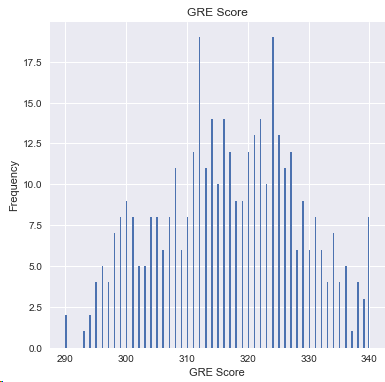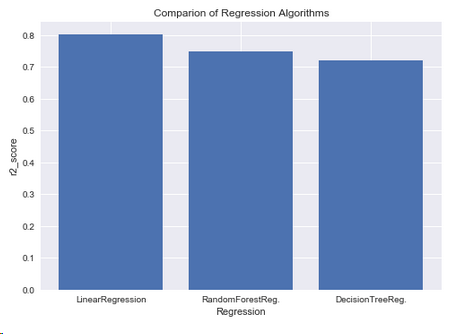Python-根据成绩分析是否继续深造
案例:该数据集的是一个关于每个学生成绩的数据集,接下来我们对该数据集进行分析,判断学生是否适合继续深造
数据集特征展示
GRE 成绩 (290 to 340)
TOEFL 成绩(92 to 120)
学校等级 (1 to 5)
自身的意愿 (1 to 5)
推荐信的力度 (1 to 5)
CGPA成绩 (6.8 to 9.92)
是否有研习经验 (0 or 1)
读硕士的意向 (0.34 to 0.97)
1.导入包
import numpy as np
import pandas as pd
import matplotlib.pyplot as plt
import seaborn as sns
import os,sys
2.导入并查看数据集
df = pd.read_csv("D:\\machine-learning\\score\\Admission_Predict.csv",sep = ",")
print('There are ',len(df.columns),'columns')
for c in df.columns:
sys.stdout.write(str(c)+', '
There are 9 columns
Serial No., GRE Score, TOEFL Score, University Rating, SOP, LOR , CGPA, Research, Chance of Admit ,
一共有9列特征
df.info()
<class 'pandas.core.frame.DataFrame'>
RangeIndex: 400 entries, 0 to 399
Data columns (total 9 columns):
Serial No. 400 non-null int64
GRE Score 400 non-null int64
TOEFL Score 400 non-null int64
University Rating 400 non-null int64
SOP 400 non-null float64
LOR 400 non-null float64
CGPA 400 non-null float64
Research 400 non-null int64
Chance of Admit 400 non-null float64
dtypes: float64(4), int64(5)
memory usage: 28.2 KB 数据集信息:
1.数据有9个特征,分别是学号,GRE分数,托福分数,学校等级,SOP,LOR,CGPA,是否参加研习,进修的几率
2.数据集中没有空值
3.一共有400条数据
# 整理列名称
df = df.rename(columns={'Chance of Admit ':'Chance of Admit'})
# 显示前5列数据
df.head()

3.查看每个特征的相关性
fig,ax = plt.subplots(figsize=(10,10))
sns.heatmap(df.corr(),ax=ax,annot=True,linewidths=0.05,fmt='.2f',cmap='magma')
plt.show()

结论:1.最有可能影响是否读硕士的特征是GRE,CGPA,TOEFL成绩
2.影响相对较小的特征是LOR,SOP,和Research
4.数据可视化,双变量分析
4.1 进行Research的人数
print("Not Having Research:",len(df[df.Research == 0]))
print("Having Research:",len(df[df.Research == 1]))
y = np.array([len(df[df.Research == 0]),len(df[df.Research == 1])])
x = np.arange(2)
plt.bar(x,y)
plt.title("Research Experience")
plt.xlabel("Canditates")
plt.ylabel("Frequency")
plt.xticks(x,('Not having research','Having research'))
plt.show()

结论:进行research的人数是219,本科没有research人数是181
4.2 学生的托福成绩
y = np.array([df['TOEFL Score'].min(),df['TOEFL Score'].mean(),df['TOEFL Score'].max()])
x = np.arange(3)
plt.bar(x,y)
plt.title('TOEFL Score')
plt.xlabel('Level')
plt.ylabel('TOEFL Score')
plt.xticks(x,('Worst','Average','Best'))
plt.show()

结论:最低分92分,最高分满分,进修学生的英语成绩很不错
4.3 GRE成绩
df['GRE Score'].plot(kind='hist',bins=200,figsize=(6,6))
plt.title('GRE Score')
plt.xlabel('GRE Score')
plt.ylabel('Frequency')
plt.show()

结论:310和330的分值的学生居多
4.4 CGPA和学校等级的关系
plt.scatter(df['University Rating'],df['CGPA'])
plt.title('CGPA Scores for University ratings')
plt.xlabel('University Rating')
plt.ylabel('CGPA')
plt.show()

结论:学校越好,学生的GPA可能就越高
4.5 GRE成绩和CGPA的关系
plt.scatter(df['GRE Score'],df['CGPA'])
plt.title('CGPA for GRE Scores')
plt.xlabel('GRE Score')
plt.ylabel('CGPA')
plt.show()

结论:GPA基点越高,GRE分数越高,2者的相关性很大
4.6 托福成绩和GRE成绩的关系
df[df['CGPA']>=8.5].plot(kind='scatter',x='GRE Score',y='TOEFL Score',color='red')
plt.xlabel('GRE Score')
plt.ylabel('TOEFL Score')
plt.title('CGPA >= 8.5')
plt.grid(True)
plt.show()

结论:多数情况下GRE和托福成正相关,但是GRE分数高,托福一定高。
4.6 学校等级和是否读硕士的关系
s = df[df['Chance of Admit'] >= 0.75]['University Rating'].value_counts().head(5)
plt.title('University Ratings of Candidates with an 75% acceptance chance')
s.plot(kind='bar',figsize=(20,10),cmap='Pastel1')
plt.xlabel('University Rating')
plt.ylabel('Candidates')
plt.show()

结论:排名靠前的学校的学生,进修的可能性更大
4.7 SOP和GPA的关系
plt.scatter(df['CGPA'],df['SOP'])
plt.xlabel('CGPA')
plt.ylabel('SOP')
plt.title('SOP for CGPA')
plt.show()

结论: GPA很高的学生,选择读硕士的自我意愿更强烈
4.8 SOP和GRE的关系
plt.scatter(df['GRE Score'],df['SOP'])
plt.xlabel('GRE Score')
plt.ylabel('SOP')
plt.title('SOP for GRE Score')
plt.show()

结论:读硕士意愿强的学生,GRE分数较高
5.模型
5.1 准备数据集
# 读取数据集
df = pd.read_csv('D:\\machine-learning\\score\\Admission_Predict.csv',sep=',') serialNO = df['Serial No.'].values df.drop(['Serial No.'],axis=1,inplace=True)
df = df.rename(columns={'Chance of Admit ':'Chance of Admit'}) # 分割数据集
y = df['Chance of Admit'].values
x = df.drop(['Chance of Admit'],axis=1) from sklearn.model_selection import train_test_split
x_train,x_test,y_train,y_test = train_test_split(x,y,test_size=0.2,random_state=42)
# 归一化数据
from sklearn.preprocessing import MinMaxScaler
scaleX = MinMaxScaler(feature_range=[0,1])
x_train[x_train.columns] = scaleX.fit_transform(x_train[x_train.columns])
x_test[x_test.columns] = scaleX.fit_transform(x_test[x_test.columns])
5.2 回归
5.2.1 线性回归
from sklearn.linear_model import LinearRegression lr = LinearRegression()
lr.fit(x_train,y_train)
y_head_lr = lr.predict(x_test) print('Real value of y_test[1]: '+str(y_test[1]) + ' -> predict value: ' + str(lr.predict(x_test.iloc[[1],:])))
print('Real value of y_test[2]: '+str(y_test[2]) + ' -> predict value: ' + str(lr.predict(x_test.iloc[[2],:]))) from sklearn.metrics import r2_score
print('r_square score: ',r2_score(y_test,y_head_lr))
y_head_lr_train = lr.predict(x_train)
print('r_square score(train data):',r2_score(y_train,y_head_lr_train))

5.2.2 随机森林回归
from sklearn.ensemble import RandomForestRegressor rfr = RandomForestRegressor(n_estimators=100,random_state=42)
rfr.fit(x_train,y_train)
y_head_rfr = rfr.predict(x_test) print('Real value of y_test[1]: '+str(y_test[1]) + ' -> predict value: ' + str(rfr.predict(x_test.iloc[[1],:])))
print('Real value of y_test[2]: '+str(y_test[2]) + ' -> predict value: ' + str(rfr.predict(x_test.iloc[[2],:]))) from sklearn.metrics import r2_score
print('r_square score: ',r2_score(y_test,y_head_rfr))
y_head_rfr_train = rfr.predict(x_train)
print('r_square score(train data):',r2_score(y_train,y_head_rfr_train))

5.2.3 决策树回归
from sklearn.tree import DecisionTreeRegressor dt = DecisionTreeRegressor(random_state=42)
dt.fit(x_train,y_train)
y_head_dt = dt.predict(x_test) print('Real value of y_test[1]: '+str(y_test[1]) + ' -> predict value: ' + str(dt.predict(x_test.iloc[[1],:])))
print('Real value of y_test[2]: '+str(y_test[2]) + ' -> predict value: ' + str(dt.predict(x_test.iloc[[2],:]))) from sklearn.metrics import r2_score
print('r_square score: ',r2_score(y_test,y_head_dt))
y_head_dt_train = dt.predict(x_train)
print('r_square score(train data):',r2_score(y_train,y_head_dt_train))

5.2.4 三种回归方法比较
y = np.array([r2_score(y_test,y_head_lr),r2_score(y_test,y_head_rfr),r2_score(y_test,y_head_dt)])
x = np.arange(3)
plt.bar(x,y)
plt.title('Comparion of Regression Algorithms')
plt.xlabel('Regression')
plt.ylabel('r2_score')
plt.xticks(x,("LinearRegression","RandomForestReg.","DecisionTreeReg."))
plt.show()

结论 : 回归算法中,线性回归的性能更优
5.2.5 三种回归方法与实际值的比较
red = plt.scatter(np.arange(0,80,5),y_head_lr[0:80:5],color='red')
blue = plt.scatter(np.arange(0,80,5),y_head_rfr[0:80:5],color='blue')
green = plt.scatter(np.arange(0,80,5),y_head_dt[0:80:5],color='green')
black = plt.scatter(np.arange(0,80,5),y_test[0:80:5],color='black')
plt.title('Comparison of Regression Algorithms')
plt.xlabel('Index of candidate')
plt.ylabel('Chance of admit')
plt.legend([red,blue,green,black],['LR','RFR','DT','REAL'])
plt.show()

结论:在数据集中有70%的候选人有可能读硕士,从上图来看还有些点没有很好的得到预测
5.3 分类算法
5.3.1 准备数据
df = pd.read_csv('D:\\machine-learning\\score\\Admission_Predict.csv',sep=',')
SerialNO = df['Serial No.'].values
df.drop(['Serial No.'],axis=1,inplace=True)
df = df.rename(columns={'Chance of Admit ':'Chance of Admit'})
y = df['Chance of Admit'].values
x = df.drop(['Chance of Admit'],axis=1)
from sklearn.model_selection import train_test_split
x_train,x_test,y_train,y_test = train_test_split(x,y,test_size=0.2,random_state=42)
from sklearn.preprocessing import MinMaxScaler
scaleX = MinMaxScaler(feature_range=[0,1])
x_train[x_train.columns] = scaleX.fit_transform(x_train[x_train.columns])
x_test[x_test.columns] = scaleX.fit_transform(x_test[x_test.columns])
# 如果chance >0.8, chance of admit 就是1,否则就是0
y_train_01 = [1 if each > 0.8 else 0 for each in y_train]
y_test_01 = [1 if each > 0.8 else 0 for each in y_test]
y_train_01 = np.array(y_train_01)
y_test_01 = np.array(y_test_01)
5.3.2 逻辑回归
from sklearn.linear_model import LogisticRegression lrc = LogisticRegression()
lrc.fit(x_train,y_train_01)
print('score: ',lrc.score(x_test,y_test_01))
print('Real value of y_test_01[1]: '+str(y_test_01[1]) + ' -> predict value: ' + str(lrc.predict(x_test.iloc[[1],:])))
print('Real value of y_test_01[2]: '+str(y_test_01[2]) + ' -> predict value: ' + str(lrc.predict(x_test.iloc[[2],:]))) from sklearn.metrics import confusion_matrix
cm_lrc = confusion_matrix(y_test_01,lrc.predict(x_test)) f,ax = plt.subplots(figsize=(5,5))
sns.heatmap(cm_lrc,annot=True,linewidths=0.5,linecolor='red',fmt='.0f',ax=ax)
plt.title('Test for Test dataset')
plt.xlabel('predicted y values')
plt.ylabel('real y value')
plt.show() from sklearn.metrics import recall_score,precision_score,f1_score
print('precision_score is : ',precision_score(y_test_01,lrc.predict(x_test)))
print('recall_score is : ',recall_score(y_test_01,lrc.predict(x_test)))
print('f1_score is : ',f1_score(y_test_01,lrc.predict(x_test))) # Test for Train Dataset: cm_lrc_train = confusion_matrix(y_train_01,lrc.predict(x_train))
f,ax = plt.subplots(figsize=(5,5))
sns.heatmap(cm_lrc_train,annot=True,linewidths=0.5,linecolor='blue',fmt='.0f',ax=ax)
plt.title('Test for Train dataset')
plt.xlabel('predicted y values')
plt.ylabel('real y value')
plt.show()

结论:1.通过混淆矩阵,逻辑回归算法在训练集样本上,有23个分错的样本,有72人想进一步读硕士
2.在测试集上有7个分错的样本
5.3.3 支持向量机(SVM)
from sklearn.svm import SVC svm = SVC(random_state=1,kernel='rbf')
svm.fit(x_train,y_train_01)
print('score: ',svm.score(x_test,y_test_01))
print('Real value of y_test_01[1]: '+str(y_test_01[1]) + ' -> predict value: ' + str(svm.predict(x_test.iloc[[1],:])))
print('Real value of y_test_01[2]: '+str(y_test_01[2]) + ' -> predict value: ' + str(svm.predict(x_test.iloc[[2],:]))) from sklearn.metrics import confusion_matrix
cm_svm = confusion_matrix(y_test_01,svm.predict(x_test)) f,ax = plt.subplots(figsize=(5,5))
sns.heatmap(cm_svm,annot=True,linewidths=0.5,linecolor='red',fmt='.0f',ax=ax)
plt.title('Test for Test dataset')
plt.xlabel('predicted y values')
plt.ylabel('real y value')
plt.show() from sklearn.metrics import recall_score,precision_score,f1_score
print('precision_score is : ',precision_score(y_test_01,svm.predict(x_test)))
print('recall_score is : ',recall_score(y_test_01,svm.predict(x_test)))
print('f1_score is : ',f1_score(y_test_01,svm.predict(x_test))) # Test for Train Dataset: cm_svm_train = confusion_matrix(y_train_01,svm.predict(x_train))
f,ax = plt.subplots(figsize=(5,5))
sns.heatmap(cm_svm_train,annot=True,linewidths=0.5,linecolor='blue',fmt='.0f',ax=ax)
plt.title('Test for Train dataset')
plt.xlabel('predicted y values')
plt.ylabel('real y value')
plt.show()

结论:1.通过混淆矩阵,SVM算法在训练集样本上,有22个分错的样本,有70人想进一步读硕士
2.在测试集上有8个分错的样本
5.3.4 朴素贝叶斯
from sklearn.naive_bayes import GaussianNB nb = GaussianNB()
nb.fit(x_train,y_train_01)
print('score: ',nb.score(x_test,y_test_01))
print('Real value of y_test_01[1]: '+str(y_test_01[1]) + ' -> predict value: ' + str(nb.predict(x_test.iloc[[1],:])))
print('Real value of y_test_01[2]: '+str(y_test_01[2]) + ' -> predict value: ' + str(nb.predict(x_test.iloc[[2],:]))) from sklearn.metrics import confusion_matrix
cm_nb = confusion_matrix(y_test_01,nb.predict(x_test)) f,ax = plt.subplots(figsize=(5,5))
sns.heatmap(cm_nb,annot=True,linewidths=0.5,linecolor='red',fmt='.0f',ax=ax)
plt.title('Test for Test dataset')
plt.xlabel('predicted y values')
plt.ylabel('real y value')
plt.show() from sklearn.metrics import recall_score,precision_score,f1_score
print('precision_score is : ',precision_score(y_test_01,nb.predict(x_test)))
print('recall_score is : ',recall_score(y_test_01,nb.predict(x_test)))
print('f1_score is : ',f1_score(y_test_01,nb.predict(x_test))) # Test for Train Dataset: cm_nb_train = confusion_matrix(y_train_01,nb.predict(x_train))
f,ax = plt.subplots(figsize=(5,5))
sns.heatmap(cm_nb_train,annot=True,linewidths=0.5,linecolor='blue',fmt='.0f',ax=ax)
plt.title('Test for Train dataset')
plt.xlabel('predicted y values')
plt.ylabel('real y value')
plt.show()

结论:1.通过混淆矩阵,朴素贝叶斯算法在训练集样本上,有20个分错的样本,有78人想进一步读硕士
2.在测试集上有7个分错的样本
5.3.5 随机森林分类器
from sklearn.ensemble import RandomForestClassifier rfc = RandomForestClassifier(n_estimators=100,random_state=1)
rfc.fit(x_train,y_train_01)
print('score: ',rfc.score(x_test,y_test_01))
print('Real value of y_test_01[1]: '+str(y_test_01[1]) + ' -> predict value: ' + str(rfc.predict(x_test.iloc[[1],:])))
print('Real value of y_test_01[2]: '+str(y_test_01[2]) + ' -> predict value: ' + str(rfc.predict(x_test.iloc[[2],:]))) from sklearn.metrics import confusion_matrix
cm_rfc = confusion_matrix(y_test_01,rfc.predict(x_test)) f,ax = plt.subplots(figsize=(5,5))
sns.heatmap(cm_rfc,annot=True,linewidths=0.5,linecolor='red',fmt='.0f',ax=ax)
plt.title('Test for Test dataset')
plt.xlabel('predicted y values')
plt.ylabel('real y value')
plt.show() from sklearn.metrics import recall_score,precision_score,f1_score
print('precision_score is : ',precision_score(y_test_01,rfc.predict(x_test)))
print('recall_score is : ',recall_score(y_test_01,rfc.predict(x_test)))
print('f1_score is : ',f1_score(y_test_01,rfc.predict(x_test))) # Test for Train Dataset: cm_rfc_train = confusion_matrix(y_train_01,rfc.predict(x_train))
f,ax = plt.subplots(figsize=(5,5))
sns.heatmap(cm_rfc_train,annot=True,linewidths=0.5,linecolor='blue',fmt='.0f',ax=ax)
plt.title('Test for Train dataset')
plt.xlabel('predicted y values')
plt.ylabel('real y value')
plt.show()

结论:1.通过混淆矩阵,随机森林算法在训练集样本上,有0个分错的样本,有88人想进一步读硕士
2.在测试集上有5个分错的样本
5.3.6 决策树分类器
from sklearn.tree import DecisionTreeClassifier dtc = DecisionTreeClassifier(criterion='entropy',max_depth=3)
dtc.fit(x_train,y_train_01)
print('score: ',dtc.score(x_test,y_test_01))
print('Real value of y_test_01[1]: '+str(y_test_01[1]) + ' -> predict value: ' + str(dtc.predict(x_test.iloc[[1],:])))
print('Real value of y_test_01[2]: '+str(y_test_01[2]) + ' -> predict value: ' + str(dtc.predict(x_test.iloc[[2],:]))) from sklearn.metrics import confusion_matrix
cm_dtc = confusion_matrix(y_test_01,dtc.predict(x_test)) f,ax = plt.subplots(figsize=(5,5))
sns.heatmap(cm_dtc,annot=True,linewidths=0.5,linecolor='red',fmt='.0f',ax=ax)
plt.title('Test for Test dataset')
plt.xlabel('predicted y values')
plt.ylabel('real y value')
plt.show() from sklearn.metrics import recall_score,precision_score,f1_score
print('precision_score is : ',precision_score(y_test_01,dtc.predict(x_test)))
print('recall_score is : ',recall_score(y_test_01,dtc.predict(x_test)))
print('f1_score is : ',f1_score(y_test_01,dtc.predict(x_test))) # Test for Train Dataset: cm_dtc_train = confusion_matrix(y_train_01,dtc.predict(x_train))
f,ax = plt.subplots(figsize=(5,5))
sns.heatmap(cm_dtc_train,annot=True,linewidths=0.5,linecolor='blue',fmt='.0f',ax=ax)
plt.title('Test for Train dataset')
plt.xlabel('predicted y values')
plt.ylabel('real y value')
plt.show()

结论:1.通过混淆矩阵,决策树算法在训练集样本上,有20个分错的样本,有78人想进一步读硕士
2.在测试集上有7个分错的样本
5.3.7 K临近分类器
from sklearn.neighbors import KNeighborsClassifier scores = []
for each in range(1,50):
knn_n = KNeighborsClassifier(n_neighbors = each)
knn_n.fit(x_train,y_train_01)
scores.append(knn_n.score(x_test,y_test_01)) plt.plot(range(1,50),scores)
plt.xlabel('k')
plt.ylabel('Accuracy')
plt.show() knn = KNeighborsClassifier(n_neighbors=7)
knn.fit(x_train,y_train_01)
print('score 7 : ',knn.score(x_test,y_test_01))
print('Real value of y_test_01[1]: '+str(y_test_01[1]) + ' -> predict value: ' + str(knn.predict(x_test.iloc[[1],:])))
print('Real value of y_test_01[2]: '+str(y_test_01[2]) + ' -> predict value: ' + str(knn.predict(x_test.iloc[[2],:]))) from sklearn.metrics import confusion_matrix
cm_knn = confusion_matrix(y_test_01,knn.predict(x_test)) f,ax = plt.subplots(figsize=(5,5))
sns.heatmap(cm_knn,annot=True,linewidths=0.5,linecolor='red',fmt='.0f',ax=ax)
plt.title('Test for Test dataset')
plt.xlabel('predicted y values')
plt.ylabel('real y value')
plt.show() from sklearn.metrics import recall_score,precision_score,f1_score
print('precision_score is : ',precision_score(y_test_01,knn.predict(x_test)))
print('recall_score is : ',recall_score(y_test_01,knn.predict(x_test)))
print('f1_score is : ',f1_score(y_test_01,knn.predict(x_test))) # Test for Train Dataset: cm_knn_train = confusion_matrix(y_train_01,knn.predict(x_train))
f,ax = plt.subplots(figsize=(5,5))
sns.heatmap(cm_knn_train,annot=True,linewidths=0.5,linecolor='blue',fmt='.0f',ax=ax)
plt.title('Test for Train dataset')
plt.xlabel('predicted y values')
plt.ylabel('real y value')
plt.show()


结论:1.通过混淆矩阵,K临近算法在训练集样本上,有22个分错的样本,有71人想进一步读硕士
2.在测试集上有7个分错的样本
5.3.8 分类器比较
y = np.array([lrc.score(x_test,y_test_01),svm.score(x_test,y_test_01),nb.score(x_test,y_test_01),
dtc.score(x_test,y_test_01),rfc.score(x_test,y_test_01),knn.score(x_test,y_test_01)])
x = np.arange(6)
plt.bar(x,y)
plt.title('Comparison of Classification Algorithms')
plt.xlabel('Classification')
plt.ylabel('Score')
plt.xticks(x,("LogisticReg.","SVM","GNB","Dec.Tree","Ran.Forest","KNN"))
plt.show()

结论:随机森林和朴素贝叶斯二者的预测值都比较高
5.4 聚类算法
5.4.1 准备数据
df = pd.read_csv('D:\\machine-learning\\score\\Admission_Predict.csv',sep=',')
df = df.rename(columns={'Chance of Admit ':'Chance of Admit'})
serialNo = df['Serial No.']
df.drop(['Serial No.'],axis=1,inplace=True)
df = (df - np.min(df)) / (np.max(df)-np.min(df))
y = df['Chance of Admit']
x = df.drop(['Chance of Admit'],axis=1)
5.4.2 降维
from sklearn.decomposition import PCA pca = PCA(n_components=1,whiten=True)
pca.fit(x)
x_pca = pca.transform(x)
x_pca = x_pca.reshape(400)
dictionary = {'x':x_pca,'y':y}
data = pd.DataFrame(dictionary)
print('pca data:',data.head()) print() print('orin data:',df.head())

5.4.3 K均值聚类
from sklearn.cluster import KMeans wcss = []
for k in range(1,15):
kmeans = KMeans(n_clusters=k)
kmeans.fit(x)
wcss.append(kmeans.inertia_)
plt.plot(range(1,15),wcss)
plt.xlabel('Kmeans')
plt.ylabel('WCSS')
plt.show() df["Serial No."] = serialNo
kmeans = KMeans(n_clusters=3)
clusters_knn = kmeans.fit_predict(x)
df['label_kmeans'] = clusters_knn plt.scatter(df[df.label_kmeans == 0 ]["Serial No."],df[df.label_kmeans == 0]['Chance of Admit'],color = "red")
plt.scatter(df[df.label_kmeans == 1 ]["Serial No."],df[df.label_kmeans == 1]['Chance of Admit'],color = "blue")
plt.scatter(df[df.label_kmeans == 2 ]["Serial No."],df[df.label_kmeans == 2]['Chance of Admit'],color = "green")
plt.title("K-means Clustering")
plt.xlabel("Candidates")
plt.ylabel("Chance of Admit")
plt.show() plt.scatter(data.x[df.label_kmeans == 0 ],data[df.label_kmeans == 0].y,color = "red")
plt.scatter(data.x[df.label_kmeans == 1 ],data[df.label_kmeans == 1].y,color = "blue")
plt.scatter(data.x[df.label_kmeans == 2 ],data[df.label_kmeans == 2].y,color = "green")
plt.title("K-means Clustering")
plt.xlabel("X")
plt.ylabel("Chance of Admit")
plt.show()


结论:数据集分成三个类别,一部分学生是决定继续读硕士,一部分放弃,还有一部分学生的比较犹豫,但是深造的可能性较大
5.4.4 层次聚类
from scipy.cluster.hierarchy import linkage,dendrogram merg = linkage(x,method='ward')
dendrogram(merg,leaf_rotation=90)
plt.xlabel('data points')
plt.ylabel('euclidean distance')
plt.show() from sklearn.cluster import AgglomerativeClustering hiyerartical_cluster = AgglomerativeClustering(n_clusters=3,affinity='euclidean',linkage='ward')
clusters_hiyerartical = hiyerartical_cluster.fit_predict(x)
df['label_hiyerartical'] = clusters_hiyerartical plt.scatter(df[df.label_hiyerartical == 0 ]["Serial No."],df[df.label_hiyerartical == 0]['Chance of Admit'],color = "red")
plt.scatter(df[df.label_hiyerartical == 1 ]["Serial No."],df[df.label_hiyerartical == 1]['Chance of Admit'],color = "blue")
plt.scatter(df[df.label_hiyerartical == 2 ]["Serial No."],df[df.label_hiyerartical == 2]['Chance of Admit'],color = "green")
plt.title('Hierarchical Clustering')
plt.xlabel('Candidates')
plt.ylabel('Chance of Admit')
plt.show() plt.scatter(data[df.label_hiyerartical == 0].x,data.y[df.label_hiyerartical==0],color='red')
plt.scatter(data[df.label_hiyerartical == 1].x,data.y[df.label_hiyerartical==1],color='blue')
plt.scatter(data[df.label_hiyerartical == 2].x,data.y[df.label_hiyerartical==2],color='green')
plt.title('Hierarchical Clustering')
plt.xlabel('X')
plt.ylabel('Chance of Admit')
plt.show()


结论:从层次聚类的结果中,可以看出和K均值聚类的结果一致,只不过确定了聚类k的取值3
结论:通过本词入门数据集的训练,可以掌握
1.一些特征的展示的方法
2.如何调用sklearn 的API
3.如何取比较不同模型之间的好坏
代码+数据集:https://github.com/Mounment/python-data-analyze/tree/master/kaggle/score
如果有用的话,记得打一个星星,谢谢

Python-根据成绩分析是否继续深造的更多相关文章
- Python文章相关性分析---金庸武侠小说分析
百度到<金庸小说全集 14部>全(TXT)作者:金庸 下载下来,然后读取内容with open('names.txt') as f: data = [line.strip() for li ...
- [python]Python代码安全分析工具(Bandit)
简介: Bandit是一款Python源码分析框架,可用于Python代码的安全性分析.Bandit使用标准库中的ast模块,将Python源码解析成Python语法节点构成的树.Bandit允许用户 ...
- 用python探索和分析网络数据
Edited by Markdown Refered from: John Ladd, Jessica Otis, Christopher N. Warren, and Scott Weingart, ...
- python爬虫之分析Ajax请求抓取抓取今日头条街拍美图(七)
python爬虫之分析Ajax请求抓取抓取今日头条街拍美图 一.分析网站 1.进入浏览器,搜索今日头条,在搜索栏搜索街拍,然后选择图集这一栏. 2.按F12打开开发者工具,刷新网页,这时网页回弹到综合 ...
- Python文章相关性分析---金庸武侠小说分析-2018.1.16
最近常听同事提及相关性分析,正巧看到这个google的开源库,并把相关操作与调试结果记录下来. 输出结果: 比较有意思的巧合是黄蓉使出打狗棒,郭靖就用了降龙十八掌,再后测试了名词的解析. 小说集可以百 ...
- python 代码性能分析 库
问题描述 1.Python开发的程序在使用过程中很慢,想确定下是哪段代码比较慢: 2.Python开发的程序在使用过程中占用内存很大,想确定下是哪段代码引起的: 解决方案 使用profile分析分析c ...
- 使用flask做网页的excel成绩分析
使用到的技术:pyecharts flask 首先 pip install flask 和下载pip install pyecharts==0.5.5 项目结构: 代码: from flask imp ...
- 利用Python进行异常值分析实例代码
利用Python进行异常值分析实例代码 异常值是指样本中的个别值,也称为离群点,其数值明显偏离其余的观测值.常用检测方法3σ原则和箱型图.其中,3σ原则只适用服从正态分布的数据.在3σ原则下,异常值被 ...
- Python程序设计《集美大学各省成绩分析》
分析文件‘集美大学各省录取分数.xlsx’,完成以下功能: 1)集美大学2015-2018年间不同省份在本一批的平均分数,柱状图展示排名前10的省份, 2)分析福建省这3年各批次成绩情况,使用折线图展 ...
随机推荐
- Spring MVC学习总结(6)——一些Spring MVC的使用技巧
APP服务端的Token验证 通过拦截器对使用了 @Authorization 注解的方法进行请求拦截,从http header中取出token信息,验证其是否合法.非法直接返回401错误,合法将to ...
- Spring Cloud学习笔记【九】配置中心Spring Cloud Config
Spring Cloud Config 是 Spring Cloud 团队创建的一个全新项目,用来为分布式系统中的基础设施和微服务应用提供集中化的外部配置支持,它分为服务端与客户端两个部分.其中服务端 ...
- 洛谷——P1970 花匠
https://www.luogu.org/problem/show?pid=1970 题目描述 花匠栋栋种了一排花,每株花都有自己的高度.花儿越长越大,也越来越挤.栋栋决定 把这排中的一部分花移走, ...
- hdu 1695 GCD (欧拉函数、容斥原理)
GCD Time Limit: 6000/3000 MS (Java/Others) Memory Limit: 32768/32768 K (Java/Others) Total Submis ...
- HDU 2444 The Accomodation of Students 二分图判定+最大匹配
题目来源:HDU 2444 The Accomodation of Students 题意:n个人能否够分成2组 每组的人不能相互认识 就是二分图判定 能够分成2组 每组选一个2个人认识能够去一个双人 ...
- 浏览器下载img标签Base64图片
https://blog.csdn.net/qq_42076140/article/details/82113622 原文地址 <a href="javascript:downl ...
- android 客户端 Cookie处理
Cookie,有时也用其复数形式Cookies,指某些网站为了辨别用户身份.进行session跟踪而储存在用户本地终端上的数据(通常经过加密). Cookie最早是网景公司的前雇员Lou Montul ...
- AIX 软件包结构
AIX installp软件包结构 1. usr部分 2. / (root)部分 3. share部分 AIX 为了实现在客户机 / 服务器环境下安装的灵活性将安装包划分为 usr 部分 .r ...
- Inter-process Communication (IPC)
For Developers > Design Documents > Inter-process Communication (IPC) 目录 1 Overview 1.1 I ...
- 微信小程序官方文档中的加密算法
用Nodejs来算一下:
